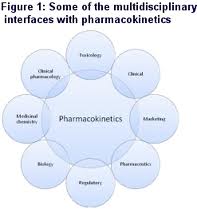Pharmacokinetics- Major effects
The side effects caused by anti-arrhythmic drugs often occur at serum concentrations only a little higher than their minimum therapeutic concentration. These drugs must be administered in such a way as to produce serum concentrations within a narrow therapeutic window. During long term maintenance therapy, this is usually accomplished by administering enough drugs to offset elimination, at intervals equal to the elimination half-life. When anti-arrhythmic therapy is not emergently required, treatment can begin at a low dose, with gradual dose escalation until the desired effect is produced. However, it is common for ventricular arrhythias to require urgent therapy. Here the goal is to quickly produce a therapeutic serum concentration and subsequently, to keep the concentration in the therapeutic range. Typically, a loading dose is given to raise the serum concentration into the therapeutic range. At the same time, a maintenance dose is started in order to offset drug elimination. But if only these steps are taken, the patient may be transiently unprotected following the bolus. This is because most anti-arhythmic drugs follows two compartment pharmacokinetics a bolus, drugs disappear from the circulation the central compartment by two routes, elimination and distribution into adipose tissue and other sites the peripheral compartment. A drug leaves the central circulation by he latter route until its concentrate in the peripheral compartment equals the concentration in the central compartment. To keep the serum concentration of a drug within the therapeutic range following a bolus, the consultant should supplement the maintenance dose with additional boluses to offset distribution. Dosing schedules have been developed for each anti-arrhythmic drug. Use of these schedules should be tempered by an appreciation of how pharmacokinetics might be altered in the particular patient. The dose of an anti-arrhythmic drug should be adjusted with a view to potential interactions with other drugs that the patient might be taking. Also, various disease states can affect the pharmacokinetic characteristics of drugs. The absorption of oral drugs can be reduced by bowel resection, mesenteric ischemia, or congested intestinal mucosa. On the other hand, bioavailability can be increased by hepatic dysfunction, which reduces the extent to which the liver removes orally administered drugs from the portal circulation. Drug elimination can be reduced or even abolished by hepatic or renal dysfunction, depending on the site of metabolism or elimination of the drug. Disease state has a variable effect on the size of the central and peripheral compartments, which are critical determinants of the appropriate size of a loading dose. The usual way to compensate for variability in pharmacokinetics is to monitor for efficacy and side effects and to monitor serum concentrations of drugs. Serum concentration measurements are useful, although the concentrations of active metabolites may not be measured. Also, serum concentrations of drugs do not reflect the free or protein bound fractions. The serum protein which binds most anti-arrhythmic drugs is an acute phase reactant and its erum concentration rises during , acute MI, during renal transplant, with malignancy, in the postoperative period, in old age, and in general as a response to any physical stress. As a consequence, in these situations the percentage of drug available to act on the cardiac membrane can be reduced.


